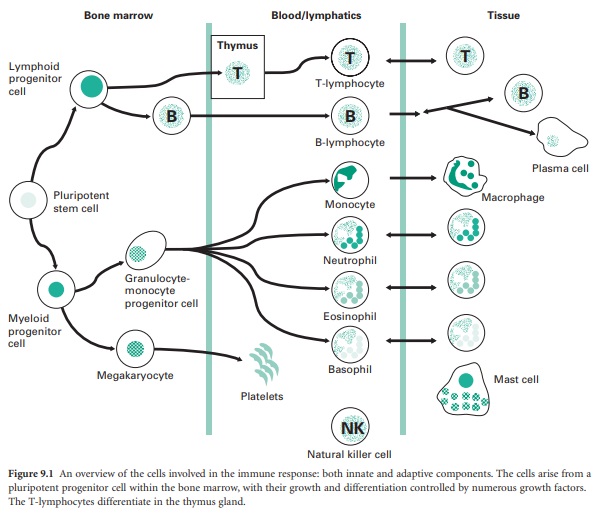Cells of the Immune System
| Home | | Pharmaceutical Microbiology | | Pharmaceutical Microbiology |Chapter: Pharmaceutical Microbiology : Immunology
A schematic overview of the cells involved in both the innate and adaptive components of the immune response. Most of the cells involved in the immune system arise from progenitor cell populations within the bone marrow.
CELLS OF THE IMMUNE SYSTEM
A schematic overview of the cells
involved in both the innate and adaptive components of the immune response is
shown in Figure 9.1. Most of the cells involved in the immune
system arise from progenitor cell populations within the bone marrow. The
differentiation of these progenitor cells is under the control of a variety of
growth factors, e.g. granulocyte-or macrophage-colony stimulating factors
(G-CSF and M-CSF, respectively) released by monocyte and macrophage cells as
well as by fibroblasts and activated endothelial cells. These growth factors
promote the growth and maturation of monocyte and granulocyte populations
within the bone marrow before their release into the lymphoid and blood
circulations.

The principal cells of the innate immune system include the following:
•
Mononuclear phagocytic cells, which are short-lived (< 8 hours) monocytes in the blood
circulation that migrate into tissues and undergo further differentiation to
give rise to the long-lived and key effector cell—the macrophage.
•
The granulocyte cell populations
which include the neutrophil, basophil and eosinophil.
•
The mast cell which
is a tissue-resident cell that is triggered by tissue damage or infection to
release numerous initiating factors leading to an inflammatory response. Such
initiating factors include histamine, leukotrienes B4, C4 and D4, proinflammatory
cytokines (signal proteins released by leucocytes—white blood cells), such as
tumour necrosis factor-α (TNF-α), and chemotactic substances such as
interleukin-8 (IL-8). The sudden degranulation of the contents of mast cells is
also responsible for the acute anaphylactic reactions to bee stings,
penicillins, nuts, etc.
•
The natural killer (NK)
cell which has a phenotype similar to that of lymphocytes but lacks their
specific recognition receptors. The NK cell exploits non-specific recognition
to elicit cytotoxic actions against host cells infected with virus and those
host cells that have acquired tumour cell characteristics.
The lymphocyte populations also arise
from bone marrow progenitor cells. The B-lymphocytes mature or differentiate in
the bone marrow before leaving to circulate in the blood and lymph, while
T-lymphocytes undergo maturation in the thymus. Antibodies mediating the
effector functions of the humoral immune system are produced and secreted from
a differentiated B-lymphocyte cell population termed plasma cells.
Related Topics
